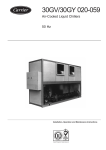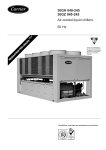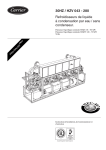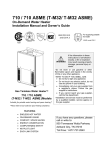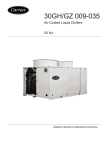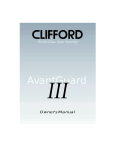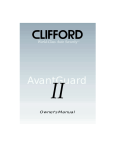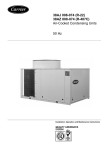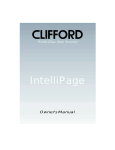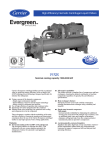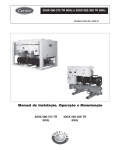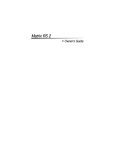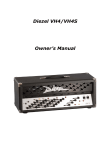Download Carrier 30H Operating instructions
Transcript
30HT,HQ,HW 043-280 30HZ,HZ"P",HZ"V" 043-280 Liquid chillers and heat pumps PR O C DIA O L N O TR G O L 50 Hz Installation, operation and maintenance instructions QUALITY ASSURANCE SYSTEM 1 CONTENTS Page Start-up checklist .......................................................................................................................................................................... 3 Dimensions/clearances ................................................................................................................................................................. 4 Technical/electrical data .............................................................................................................................................................. 6 Application data ............................................................................................................................................................................ 8 Maximum chilled water flow ......................................................................................................................................................... 8 Water loop volume ......................................................................................................................................................................... 8 Condenser water flow rates ............................................................................................................................................................ 8 Condenser water flow restrictor ..................................................................................................................................................... 8 Installation ..................................................................................................................................................................................... 9 Safety considerations ...................................................................................................................................................................... 9 Preliminary checks ......................................................................................................................................................................... 9 Moving and siting the unit .............................................................................................................................................................. 9 Check compressor mountings ......................................................................................................................................................... 9 Water connections ...................................................................................................................................................................... 10 Condenser connections ................................................................................................................................................................. 10 Freeze protection .......................................................................................................................................................................... 10 Installation of units with remote condensers ........................................................................................................................... 11 Power supply ............................................................................................................................................................................... 11 Electrical checks ........................................................................................................................................................................... 11 Start-up ........................................................................................................................................................................................ 11 Preliminary checks ....................................................................................................................................................................... 11 Actual start-up .............................................................................................................................................................................. 12 High pressure switch control ........................................................................................................................................................ 12 Servicing refrigeration components .......................................................................................................................................... 12 General maintenance .................................................................................................................................................................... 12 Liquid refrigerant charging ........................................................................................................................................................... 12 Compressors ................................................................................................................................................................................. 13 Heat exchangers ............................................................................................................................................................................ 14 Troubleshooting chart ................................................................................................................................................................ 16 The photo on the front cover is only for illustration purposes and not contractually binding (photo shows unit with optional compressor sound enclosure). The manufacturer reserves the right to make modifications at any time without prior notice. 2 START-UP CHECK LIST Equipment sold by: Installed by: Site address: Equipment type and serial numbers: Start-up date: Refrigerant: Supply voltage: Phase imbalance: Ph. 1 V Ph. 2 V Ph. 3 V Current draw: Ph. 1 A Ph. 2 A Ph. 3 A Main circuit breaker rating: A Control circuit voltage: V Control circuit fuse: A Condenser water entering temperature: °C Condenser water leaving temperature: °C Cooler water entering temperature: °C Cooler chilled water leaving temperature: °C Suction pressure: kPa Discharge pressure: kPa Control thermostat cut-out: °C Control thermostat cut-in: °C Safety thermostat cut-out: °C Low-pressure switch cut-out: kPa Low-pressure switch cut-in: kPa High-pressure switch cut-out: kPa High-pressure switch cut-in: kPa Pressure drop through cooler: kPa Pressure drop through condenser: kPa Oil level: Oil visible in sight glass: Colour of moisture indicator: Air bubbles visible in sight glass: Commissioning engineer (name): Purchase order number: 3 Legend: Dimensions/clearances (mm) B C D E F G H J K Required clearnces for maintenance 1370 1355 1915 1915 1915 1950 2000 915 915 950 950 950 950 1275 1850 2200 2550 2500 2500 2150 2750 750 750 800 800 800 800 1000 600 600 800 800 800 800 800 600 600 800 800 800 800 1000 600 600 800 800 800 800 800 800 800 850 850 850 850 950 710 710 850 900 900 900 900 Power supply Units without condenser 043 2252 1110 052-065 2550 1095 091 2630 1300 101-121 2950 1300 141-161 3350 1300 195-225 4255 1340 250-280 4070 1680 905 905 950 950 950 950 1275 1850 2200 2500 2500 2500 2150 2750 750 750 800 800 800 800 1000 600 600 800 800 800 800 800 600 600 800 800 800 800 1000 600 600 800 800 800 800 800 800 800 850 850 850 850 950 710 710 900 900 900 900 900 30H* A Units with condenser 043 2252 052-065 2550 091 2630 101-121 2940 141-161 3350 195-225 4255 250-280 4070 Water inlet Water outlet * 30H 043 to 280 unit range (see front cover) NOTE: Certified dimensional drawings are available on request. The drawings below are not contractually binding. All dmensions are given in mm 30H* 043-065 A Evaporator C Condenser (exc. 30HZ"V" and 30HW) B H G K D J F E 4 C With condenser Without condenser Sound enclosure 30H* 091-225 Without condenser B C With condenser Sound enclosure A C Condenser (exc. 30HZ"V" and 30HW) H G K D F J E 30H* 250-280 B C With condenser Sound enclosure Without condenser A ATTENTION : 2 separate power supplies C F J H E D K G Comp. B4 on 30H 280 only Floor mounting - For unit mounting holes, weight distribution and centre of gravity coordinates, refer to the dimensional drawings supplied with the unit. These units are designed for indoor installation. Ambient temperature: Max. relative humidity: 5-40°C 50% rh at a temperature of 40°C 5 PHYSICAL DATA 30H* Net nominal cooling capacity** Standard chiller 30HT** 30HW condenserless units*** Standard chiller 30HZ** 30HZ“V” condenserless units Operating weight 30H (with condenser) 30H (without condenser) Refrigerant charge R407-C**** Circuit A Circuit B Refrigerant charge R22**** Circuit A Circuit B Compressors Quantity - Circuit A Quantity - Circuit B Control type No. of capacity steps Minimum step capacity Evaporator Net water volume No. of refrigerant circuits Water connections: Inlet and outlet Standard Drain Max. water side operating pressure Condenser Quantity Water volume Circuit A Circuit B Water connections: Circuit A Circuit B Water box air vent Water box water drain Max. water side operating pressure 043 052 065 091 101 111 121 141 161 195 225 250 280 144 136 134 126 166 157 153 144 215 208 199 194 250 234 230 216 292 280 270 260 323 300 230 278 342 321 316 297 402 380 371 351 447 417 415 388 578 538 533 500 677 633 626 588 779 729 719 677 847 792 783 735 1075 863 1165 951 1232 996 2020 1650 2350 1940 2440 1980 2490 2020 2710 2240 2810 2280 3480 2950 3780 3240 4440 3750 4870 4075 15.7 15.7 17.5 17.5 21 21 38.2 19.5 29.5 29.5 34.5 29.5 33.5 33.5 38 38 42 42 54 46.5 54 54 62.5 60.5 62.5 62.5 13.5 14 16.2 33.5 25.5 30 30 13.5 14 15.3 17.5 25.5 25.5 30 Semi-hermetic, 4 or 6 cylinders 24.2 r/s (1450 rpm) 1 1 1 2 2 2 2 1 1 1 1 2 2 2 PRO-DIALOG Plus 4 4 4 8 11 11 11 40 33 33 22 20 18 16 Direct-expansion evaporator, one or two circuits, mult-tube shell 55 63 63 92 154 154 154 2 2 2 2 2 2 2 34 34 40 40 48 43.5 48 50 59 47 59 56 2 2 2 2 3 2 3 3 4 3 4 4 11 19 11 16 5 20 6 16 7 14 8 12 199 2 199 2 242 2 242 2 276 2 276 2 kW kg kg kg % l Dia. in kPa Threaded 3” gas NFE 03005 1/2” FPT 1000 1000 1000 Shell amd multi-tube type 2 2 2 PN16 DN100 PN16 DN125 NFE 29203 PN16 DN150 1000 1000 1000 1000 1000 1000 1000 1000 1000 1000 2 2 2 2 2 2 2 2 2 2 12 25 12 12 Flat flange, brazed 2” 2” 1/2 2” 2” 18 18 25 18 25 25 25 25 30 30 37 30 37 37 51 37 51 51 2” 2” 2” 1/2 2” 2” 1/2 2” 1/2 3” 2” 1/2 3” 3” 1000 1000 1000 1000 1000 1000 l in in kPa 10 10 10 10 Threaded gas 1” 1/2 1” 1/2 3/8 NPT 3/8 NPT 1000 1000 1000 1000 1000 1000 Legend: * 30H 043 to 280 unit range (see front cover) ** Net nominal cooling capacity = gross cooling capacity minus the water pump heat against the internal evaporator pressure drop Nominal Eurovent conditions: evaporator entering/leaving water temperature 12°C and 7°C. Condenser entering/leaving water temperature 30°C and 35°C. *** Standardised conditions: evaporator entering/leaving water temperature 12°C and 7°C. Condensing temperature dew point 50°C. Fluid temperature = condensing temperature at dew point - refrigerant glide - 5 K subcooling. **** The 30H* units have a nitrogen holding charge only. 6 1000 ELECTRICAL DATA 30H* 043 Power wiring Nominal power supply** V-ph-Hz Nominal voltage range V Auxiliary circuit V-ph-Hz Heater power input 30HT kW Heater power input 30HZ kW Nominal unit power input kW Standard units 30HT Condenserless units 30HW Standard units 30HZ Condenserless units 30HZ“V” Nominal unit operating current A Standard units 30HT Condenserless units 30HW Standard units 30HZ Condenserless units 30HZ“V” Maximum unit power input*** kW Standard units 30HT High condensing pressure/condenserless units Standard units 30HZ High condensing pressure/condenserless units Maximum starting current A Standard units 30HT/HZ Standard units 30HT/HZ, option “PW” High condensing pressure/condenserless units High condensing pressure/condenserless units, option “PW” Maximum unit operating current*** A Standard units 30HT High condensing pressure/condenserless units Standard units 30HZ High condensing pressure/condenserless units 052 065 091 101 111 121 141 161 195 225 250 280 400-3-50 360-440 230-1-50 0.25 0.25 0.36 0.36 0.25 0.36 0.38 0.54 0.50 0.72 0.50 0.72 0.50 0.72 0.50 0.72 0.50 0.72 0.63 0.90 0.75 1.08 0.88 1.26 1.00 1.44 34.3 36.9 36.8 37.4 43.4 46.6 46.6 47.3 60 62 64 63 62 67 66 68 69 74 74 75 77 83 85 84 82 90 88 92 99 107 106 109 116 129 124 131 145 158 155 160 175 190 187 193 206 222 221 225 233 252 249 255 57 61 61 62 72 77 77 78 100 103 107 105 102 111 109 112 115 122 123 124 127 137 142 139 136 149 146 152 164 178 176 180 192 214 206 217 240 262 258 266 290 315 311 320 342 368 367 374 386 417 414 423 45 51 42 45 54 62 54 58 75 85 70 76 81 93 75 81 89 103 84 92 98 113 95 103 108 124 102 111 129 147 122 133 151 171 150 158 189 214 180 197 226 256 217 237 264 299 253 272 302 342 286 309 163 std 186 178 std 202 247 std 280 311 222 354 259 202 308 340 251 388 355 266 404 394 305 449 496 373 563 559 437 636 623 501 709 687 565 782 750 628 855 std std std 253 239 287 303 348 425 498 571 644 717 73 85 70 75 88 101 90 96 127 146 116 126 132 151 124 134 146 170 139 153 161 185 158 171 176 201 169 184 215 246 202 221 254 291 249 262 318 364 299 327 382 437 360 393 445 510 420 451 509 582 475 513 Legend: * 30H 043 to 280 unit range (see front cover) ** 30HZ 250-280units have two power points. For separate power supply, please refer to the table below. *** At maximum unit operating values. Size Max. unit power input, kW Max. unit current drawn, A Max. starting current, A 30HT Std 30HT“W”+ 30HQ 30HT Std 30HT“W”+ 30HQ 30HT Std 30HT“W”+ 30HQ Circ. A Circ. B Circ. A Circ. B Circ. A Circ. B Circ. A Circ. B Circ. A Circ. B Circ. A Circ. B 250 151 113 171 128 254 191 291 218 496 432 564 491 280 151 151 171 171 254 254 291 291 496 496 564 564 Size 30HZ Std Circ. A Circ. B 250 143 280 143 30HZ“V”+ "P" 30HZ Std Circ. A Circ. B Circ. A Circ. B 110 154 118 237 143 154 154 237 30HZ“V”+ "P" 30HZ Std 30HZ“V”+ "P" Circ. A Circ. B Circ. A Circ. B Circ. A Circ. B 183 256 196 496 432 564 491 237 256 256 496 496 564 564 Note: All current values are given at nominal voltage. Electrical data (cont.) • • • • 30H* units have a single power connection point (except 30H 250-280 which have two connection points). The control box includes the following standard features: Starter and motor protection devices for each compressor Control devices Field connections: All connections to the system and the electrical installations must be in full accordance with all applicable local codes. The Carrier 30H chillers are designed and built to ensure conformance with these codes. The recommendations of European standard EN 60 204-1 (machine safety - electrical machine components - part 1: general regulations) are specifically taken into account, when designing the electrical equipment. IMPORTANT: • Conformance with EN 60 204 is the best means of ensuring compliance with the Machines Directive § 1.5.1. Generally the recommendations of IEC 364 are accepted as compliance with the requirements of the installation directives. • Annex B of EN 60204-1 describes the electrical characteristics used for the operation of the machines. 1. The operating environment for the 30H chillers is specified below: • Environment* - Environment as classified in IEC 364 § 3: ambient temperature range: +5°C to +40°C, class AA4* humidity range (non-condensing)*: 50% relative humidity at 40°C 90% relative humidity at 20°C altitude: ≤ 2000 m* indoor installation* presence of water: class AD2 (possibility of water droplets)* presence of hard solids, class AE2 (no significant dust present) presence of corrosive and polluting substances, class AF1 (negligible) vibration and shock, class AG2, AH2 • Competence of personnel, class BA4* (trained personnel - IEC 364) 2. Power supply frequency variation: ≤ 2 Hz. 3. The neutral (N) line must not be connected directly to the unit (if necessary use a transformer). 4. Overcurrent protection of the power supply conductors is not provided with the unit. 5. The factory-installed circuit breaker is of type “a” (EN 60 204-1 § 5.3.2). NOTE: If particular aspects of an actual installation do not conform to the conditions described above, or if there are other conditions which should be considered, always contact your local Carrier representative. * The required protection level for this class is IP21B (according to reference document IEC 529). All 30H units are protected to IP23C and fulfill this protection condition. 7 APPLICATION DATA Condenser water flow rates 30H* Passes Minimum flow rate, l/s** Closed loop Open loop Maximum flow rate, l/s*** Maximum chilled water flow rate 043 052 065 091 101 111 121 141 161 195 225 250 280 2 2 2 2 2 2 2 2 2 2 2 2 2 1.00 1.20 1.40 2.47 2.54 3.04 3.54 3.54 3.54 4.00 4.46 5.04 5.62 12.30 14.40 16.80 29.70 30.60 36.54 42.48 42.48 42.48 48.00 53.64 60.58 67.52 The maximum chilled water flow (>0,09 l/s per kW or <2.8 K temperature difference) is limited by the maximum permitted pressure drop in the evaporator. * 30H 018 to 280 unit range (see front cover) ** Based on a water velocity of 0.3 m/s in closed-loop and 0.9 m/s in open-loop systems. ***Based on a water velocity of 3.6 m/s. Minimum cooler water flow rates 30H* Min flow rate, l/s 043 052-065 091 101-111 141-161 195-280 4.1 5.0 6.0 8.5 9.9 9.9 * 30H 043 to 280 unit range (see front cover) 3.00 3.60 4.20 7.42 7.64 9.13 10.62 10.62 10.62 12.00 13.40 15.14 16.88 Condenser water flow restrictor Water loop volume Whatever the size of the system, the water loop minimum volume is given by the following formula: CAUTION: To ensure correct operation of the units, this restrictor must be installed. It is supplied with the machine, inside the control box. Volume = CAP (kW) x N* = litres 30H* No. of passes OD, mm Location 043 091 111 195 250 2 2 2 2 2 31 47 47 47 56 Condenser 09RS 022, circuit B - water outlet Condenser 09RS 054 - water outlet Condenser 09RS 054 - water outlet Condenser 09RS 070 - water outlet Condenser 09RS 084 - water outlet where CAP is the nominal system capacity (kW) at the nominal operating conditions of the installation. Application N Air conditioning Industrial process cooling Low-ambient temperature 3.25 6.50 6.50 This volume is necessary for stable operation and accurate temperature control. It is often necessary to add a buffer water reservoir to the circuit in order to achieve the required volume. The reservoir must itself be internally baffled in order to ensure proper mixing of the liquid (water or brine). Refer to the examples below. NOTE: The compressor must not restart more than 6 times in an hour. 8 Bad Good Bad Good INSTALLATION Safety considerations Installation, start-up and servicing this equipment can be hazardous due to system pressures, electrical components and equipment location (roofs, elevated structures, etc.). Only trained, qualified installers and service mechanics should install, start-up and service this equipment. Untrained personnel can perform basic functions, such as cleaning coils. All other operations should be performed by trained service personnel. We recommend that these chillers be installed either in a basement or at ground level. If one is to be installed above ground level, first check that the permissible floor loading is adequate and that the floor is strong enough and horizontal. If necessary, strengthen and level the floor. 30HT/HZ machines require only the connection of condenser and evaporator water circuits and power and control electrical supplies. 30HW/HZ'V' units differ only in that they require the installation of pipework between the chiller and the remote condensers. Check compressor mountings Before the first start-up of the unit proceed as follows: When working on the equipment, observe precautions in the literature, and on tags, stickers, and labels attached to the equipment. • • • For 30H* 043-065 units Follow all safety codes. Wear safety glasses and work gloves. Use care in handling, rigging and setting down bulky equipment. WARNING: Before doing any work ensure that the power supply (400 V and 230 V) is disconnected, and switches and isolators are opened and tagged. During operation some parts of the unit reach or exceed temperatures of 70°C (e.g. compressor discharge side, discharge line). Only trained and qualified engineers, aware of these hot surfaces, are allowed to perform maintenance operations. Preliminary checks Check equipment received • Inspect the unit for damage or missing parts. If damage is detected, or if shipment is incomplete, immediately file a claim with the shipping company. • Confirm that the unit received is the one ordered. Compare the nameplate data with the order. • Confirm that all accessories ordered for on-site installation have been delivered, and are complete and undamaged. 1. 2. 3. Remove the wooden block located under the compressor foot. Remove the screw and washer used for transportation. Assemble screw (A), snubber (B) and plain washer ( C). For 30H* 091-280 units Moving and siting the unit Moving Do not remove skids, pallets or protective packaging until the unit is in its final position. Move the chiller using tubes or rollers, or lift it, using slings of the correct capacity. CAUTION: Only use slings at the designated lifting points which are marked on the unit. Remove the centre bolt (A) from each spring mounting, so that the compressor support can float freely. Siting Always refer to the chapter 'Dimensions and clearances' to confirm that there is adequate space for all connections and service operations. With the chiller in its final location remove the skids, and other devices used to aid in moving it. Level the unit using a spirit level, and bolt the unit to the floor or plinth. Operation of these units may be impaired if they are not level and not securely fixed to their mountings. 9 Water connections Pipe connections After welding the pipes to the flanges previously removed from the water boxes: Refer to the certified dimensional drawings for the sizes and positions of all water inlet and outlet connections. The water pipes must not transmit any radial or axial force to the heat exchangers or any vibration to the pipework or building. a. b. c. The water supply must be analysed and appropriate filtering, treatment, control devices, isolation and bleed valves and circuits built in, as necessary. Consult either a water treatment specialist or appropriate literature on the subject. d. e. f. Operating precautions The water circuit should be designed to have the least number of elbows and horizontal pipe runs at different levels. Below the basic checks to be done (see also the illustration of a typical hydraulic circuit below). • • • • • • • • • g. h. i. Note the water inlets and outlets of the heat exchangers. Install manual or automatic air purge valves at all high points in the water circuit. Use an expansion chamber or an expansion/relief valve to maintain pressure in the system. Install water thermometers in both the entering and leaving water connections close to the evaporator. Install drain valves at all low points to allow the whole circuit to be drained. Connect a stop valve in the drain line before operating the chiller. Install stop valves, close to the evaporator, in the entering and leaving water lines. Use flexible connections to reduce the transmission of vibration to the pipework. Insulate all pipework, after testing for leaks, both to reduce thermal leaks and to prevent condensation. Cover the insulation with a vapour barrier. NOTE: We recommend draining the system and disconnecting the pipework to ensure that the bolts of the heads to which the pipework is connected are correctly and uniformly tightened. If there is a leak outside the water head: a. Drain the system. b. Disconnect the water pipes. c. In the correct sequence, retighten the head bolts to the maximum torque given for the bolt size. d. Reconnect the pipework, tightening the bolts to their final torque value, i.e. the middle value in the range given for the bolt size. e. Refill the system with water. f. Pressurize the system. Freeze protection Condenser connections The condenser is of the multi-tube shell and tube type with removable water boxes to facilitate cleaning of the tubes. Cooler and water-cooled condenser protection If the chiller or the water piping is in an area where the ambient temperature can fall below 0°C it is recommended to add an antifreeze solution to protect the unit and the water piping to a temperatures of 8 K below the lowest anticipated temperature. Before making water connections tighten the bolts in both heads to the lower torque shown, following the method described. Tighten in the pairs and sequence indicated according to the size of bolt (see below) using a torque value at the low end of the range given. Water box tightening sequence Reinstall the pipes and tighten lightly to a torque at the low end of the range. Fill the system with water. Wait for 10 minutes and check for minor leaks at the water box joints at the flange joints Drain the system. Disconnect the pipework. Tighten the head bolts to their final torque (middle of the range) in the sequence illustrated. Reconnect the water pipes, tightening the flange bolts to the mid-range torque value. Refill the system with water. Pressurize the system. Use only antifreeze solutions, approved for heat exchanger duty. If the system is not protected by an antifreeze solution and will not be used during the freezing weather conditions, draining of the cooler and outdoor piping is recommended. Typical hydraulic circuit diagram Air vent Sequence 1: 1 2 3 4 Sequence 2: 5 6 7 8 Control valve Flow switch 1 5 7 Heat exchanger 3 4 Flexible connection 8 6 2 Bolt size M12 - 71-87 Nm Bolt size M16 - 171-210 Nm Bolt size M20 - 171-210 Nm Buffer tank Fill valve Filter Expansion tank 10 Pressure tap Drain Thermostat sleeve INSTALLATION OF UNITS WITH REMOTE CONDENSERS To ensure optimum and reliable operation of condenserless units (split units for connection to remote condensers) the points listed below must be followed, before connection of these machines to the remote condensers: WARNING: Operation of the chiller with an improper supply voltage or with excessive phase imbalance constitutes abuse which will invalidate the Carrier warranty. If the phase imbalance exceeds 2% for voltage, or 1% for current, contact your local electricity supply company at once and ensure that the chiller is not switched on until corrective measures have been taken. 1. Voltage phase imbalance (%) : 2. 3. 4. 5. 6. 7. Install the valves supplied with the machines on the discharge line (see unit description table below). Size the discharge piping in accordance with the recommendations of the Carrier System Design Manual (if necessary install a double riser to ensure correct oil circulation in the refrigerant circuit). Depending on the actual installation and the routing of the discharge lines it may be necessary to include an additional muffler (to reduce pulsations and noise emission) between the liquid chiller and the condenser. For component selection contact our customer support team. Select a condenser with integrated subcooler to obtain an actual subcooling of at least 3 K at the expansion device inlet (careful when determining subcooling with R-407C). Maintain a condensing pressure which is as stable as possible (pressure switch staging and/or accessory PRODIALOG card). For low-temperature and part-load operation a speed transformer may be required on the first fan stage. If the system can have several operating modes (summer/ winter, dual set point, heat reclaim...), it is necessary to include a receiver to absorb charge variations. For units not equipped with a liquid line solenoid valve (see unit description table below) this type of valve must be installed between the liquid chiller and the condenser (closed if no flow is present). This prevents refrigerant charge migration to the evaporator which could damage the compressors at the restart. Power supply The power supply must conform to the specification on the chiller nameplate. The supply voltage must be within the range specified in the electrical data table. = 100 x max. deviation from average voltage deviation Average voltage Electrical checks WARNING: Never switch off the power supply to the crankcase heaters unless the chiller is out of service for a seasonal shutdown or lengthy repair. The heaters must be re-energised for at least 24 hours before the chiller is restarted. a. b. c. d. e. Switch the unit off. Open the control circuit disconnect switch. Check the transformer connections. Ensure that the control circuit corresponds to the wiring diagram for the unit. Check that all electrical connections are secure at the terminals, contactors, bus bars and compressor terminal blocks. Start-up Preliminary checks Never be tempted to start the chiller without reading fully, and understanding, the operating instructions and without having carried out the following pre-start checks : Confirm that all crankcase heaters are working by feeling all compressor crankcases. Every compressor has a 200 W cartridge heater (see the wiring diagram). The heater remains energised even when the chiller is shut down to stop the lubricating oil from absorbing refrigerant. Check the operation of all accessories - chilled water circulating pumps, air handlers and other equipment connected to the evaporator. Follow the individual manufacturer's instructions for this equipment. For connections refer to the wiring diagrams. It is recommended to connect the auxiliary contact of the water pump contactor to ensure maximum unit safety (see wiring diagram delivered with the unit). Unit Valve range Expansion device Supplied 30HZ"V"/30HW 043-065 Factory-installed in discharge line Thermostatic 30HZ"V"/30HW 091-280 Supplied with machine, not installed Electronic Liquid line solenoid valve Option With thermostatic With electronic Standard expansion valve expansion valve Electronic Factory-installed No solenoid valve No solenoid valve 2 valves per circuit for sizes 250-280 11 Fill the chilled water circuit with clean water, and an inhibitor formulated specifically for this purpose, or fill it with another non-corrosive fluid to be chilled. Purge air at all high points in the system. If water temperatures below 5°C are likely, add the appropriate volume of ethylene glycol to prevent freezing. Confirm that the suction and discharge line stop valves are fully opened. Open the refrigerant line valves. Check again that the water circuit valves are open. Check that oil is visible in each compressor sight glass to between 1/8 and 3/8 of the total glass depth (check for all compressors). Confirm that there are no refrigerant leaks. Confirm that all crankcase heaters are firmly in place, and check the secure positioning of all control sensors. Confirm that discharge muffler securing bands and discharge line connections are tight. Check that all electrical connections are secure. Actual start-up IMPORTANT: • Commissioning and start-up of the chiller must be supervised by a qualified refrigeration engineer. • Start-up and operating tests must be carried out with a thermal load applied and water circulating in the evaporator. • All set point adjustments and control tests must be carried out before the unit is started up. • PLEASE REFER TO THE CONTROLS MANUAL FOR THE UNIT. a. b. Start up the unit. Check that all safety devices are satisfied, paticularly the high pressure switches. For this purpose: Stop the condenser water circulation pumps. Operate the machine until the high pressure switch trips and verify that the pressure does not exceed the cut-out value. Using the control point as a reference, verify the correct operation of the unit. High pressure switch control Unit Set point (bar) 30HT 30HZ 30HW/HT"W" 30HQ/HZ"W"/HZ"P" 30HZ"V" 19 22 25 25 29 SERVICING REFRIGERATION COMPONENTS Any technician attending the machine for any purpose must be a fully qualified refrigeration engineer. WARNING: Before doing any work on the machine ensure that the power is switched and locked off and that all isolators are tagged. If a refrigerant circuit is opened, it must be evacuated, and recharged, after ensuring that the refrigerant is clean and free from impurities, the filter-drier has been changed and the unit has been tested for leaks. Before any operation on a refrigerant circuit, it is necessary to remove the complete charge of refrigerant from the unit with a refrigerant charge recovery group. General maintenance Keep the unit itself and the space around it clean and free of obstructions. Remove all rubbish such as packing materials, as soon as the installation is completed. Regularly clean the exposed pipework to remove all dust and dirt. This makes detection of water leaks easier, and they can be repaired before more serious faults develop. Confirm that all screwed and bolted connections and joints are secure. Secure connections prevent leaks and vibration from developing. Check that all insulation joints are securely closed and that all insulation is firmly in place. Check all heat exchangers and all pipework. Confirm regularly that any phase imbalance in the three-phase power supply is within acceptable limits. Lubricate the hinges, locks and latches on the electrical control box doors sparingly. Liquid refrigerant charging Checking the charge WARNING: When adjusting the refrigerant charge always ensure that water is circulating in the condenser and evaporator to prevent any possibility of freezing up. Damage caused by freezing is not covered by the product warranty. 30HT/30HZ units are shipped with a full normal charge of refrigerant. Refer to the Physical Data table. If it is nevertheless necessary to add more refrigerant, run the unit at full capacity for some time and then add refrigerant until there are no bubbles in the sight glass. This will generally mean adding more refrigerant than would be needed to prevent bubbles from being seen in the sight glass. 30HW/30HZV condenserless units are shipped with only a nitrogen charge, leaving the whole system to be charged after the installation is complete. To adjust the charge continue adding liquid refrigerant, with the unit running at full capacity until there are no bubbles visible in the sight glass. WARNING: To ensure proper operation of 30HW/30HZ"V" units there must be at least 3 K of subcooling as the liquid refrigerant enters the expansion valve. 12 The units 30H* 043-280 use refrigerant. For your information, we are reproducing here some extracts from the official publication dealing with the design, installation, operation and maintenance of air conditioning and refrigera-tion systems and the training of people involved in these activities, agreed by the air conditioning and refrigeration industry. Refrigerant guidelines Refrigeration installations must be inspected and maintained regularly and rigorously by specialists. Their activities must be overseen and checked by properly trained people. To minimise discharge to the atmosphere, refrigerants and lubricating oil must be transferred using methods which reduce leaks and losses to a minimum. • Significant undercharge (large bubbles in the sight glass, drop in suction pressure). Small units (charge below 20 kg per circuit). After detection and repair completely drain the refrigerant charge, using a refrigerant recovery unit, then recharge completely, following the precautions given above. Large units (charge above 20 kg per circuit). After detection and repair completely recharge the unit as described above, operate it for a few minutes and then let a specialist carry out a chromatographic analysis to verify the composition of the blend (range: R-32: 22-24%, R-125: 23-27%, R-134a: 50-54%). Compressors • • • • • Leaks must be repaired immediately A valve on the condenser liquid refrigerant outlet line enables the refrigerant charge to be transferred to the receiver provided specifically for this purpose. If the residual pressure is too low to make the transfer alone, a purpose-built refrigerant recovery unit must be used. Compressor lubricating oil contains refrigerant. Any oil drained from a system during maintenance must therefore be handled and stored accordingly. Refrigerant under pressure must never be discharged to the atmosphere. Recharging liquid refrigerant CAUTION: 30HZ 043-280 units are charged with liquid HFC-407C refrigerant. This non-azeotropic refrigerant blend consists of 23% R-32, 25% of R-125 and 52% R-134a, and is characterised by the fact that at the time of the change in state the temperature of the liquid/vapour mixture is not constant, as with azeotropic refrigerants. All checks must be pressure tests, and the appropriate pressure/temperature ratio table must be used for the interpretation of the values. Leak detection is especially important for units charged with refrigerant R-407C. Depending on whether the leak occurs in the liquid or in the vapour phase, the proportion of the different components in the remaining liquid is not the same. NOTE: Regularly carry out leak checks and immediately repair any leak found. Undercharge If there is not enough refrigerant in the system, this is indicated by gas bubbles in the moisture sight glass. There are two possiblities: • Small undercharge (bubbles in the sight glass, no significant change in suction pressure). After detection and repair the unit can be recharged. The replenishment of the charge must always be done in the liquid phase at the liquid line. The refrigerant cylinder must contain a minimum of 10% of its initial charge. Checking the oil charge Check the oil level and add or remove oil as necessary so that the level is 1/8 to 3/8 up each sight glass with the compressors running normally. WARNING: Use only oils which have been approved for use in refrigeration compressors. Never use oil which has been exposed to air. Oils for R-22 compressors are NOT compatible with R-407C. Recommended oil: 30H* R-22 units: Mineral oil, Carrier specification No. PP 33-2 Suniso 3 GS (Sun Oil Co) Capella WF 32-150 Clavus G 32 (Shell Oil Co) Gargoyle Artic (Mobil Oil) - original charge 30HZ R-407Cunits: Mineral oil, Carrier specification No. PP 47-26 Polyolester Mobil Oil EAL 68 WARNING: All fixing devices and fittings which may have been removed during servicing must always be replaced upon completion of the work and before restarting the unit. Tightening torques to be applied Description Diameter, mm Torque, Nm Discharge valve Cylinder head Suction and liquid line flange Suction valve M16 M12 M12 M16 135-140 75-87 75-87 135-140 Compressor motor protection Circuit breaker Calibrated, thermo-magnetic, manually reset circuit breakers protect the compressors against locked rotors and excessive current draw. WARNING: Never bypass a circuit breaker or increase its setting. If a circuit breaker trips, find out why it has done so and correct the problem before resetting the breaker. 13 Discharge gas thermostat (DGT) (only for units with low temperature option) A sensor in each compressor discharge line opens to shut down the compressor if the discharge gas temperature exceeds the preset level. Cut out 146°C Cut in 113°C Crankcase heater Each compressor is fitted with an electric resistance crankcase heater which prevents any absorption of refrigerant by the compressor lubricating oil when the compressor is shut down. Each heater is held in place by a screw clip which must be secure. Prolonged exposure of the heater to air will result in its destruction. The heater is energized when the compressor is switched off. Plugging evaporator tubes A leaking tube can be plugged pending replacement. The number of tubes plugged will determine when they should be replaced. Check with Carrier the effect upon chiller performance of plugging a number of tubes. Carrier will need to know the number of tubes to be plugged and their positions. The figure below shows the Elliott method of plugging tubes. WARNING: Take care when inserting plugs not to damage the plate material between the tubes. Avoid excessive force. Clean all components with Locquic N and then coat all surfaces with several drops of Loctite 75 to ensure a good seal without applying excessive force. Elliott tube plug Tube plate WARNING: Never open or disconnect any switch or circuit breaker which will cut the supply to the heaters, unless the unit is to be shut down for lengthy service or repair or for a seasonal shut down. In all cases the heater must be energised for at least 24 hours before a compressor is restarted. Compressor protection circuit board (STARTERGUARD) Plug Ring The purpose of this card is to monitor the compressor operating environment, in particular: • • • • the crankcase heaters the contactors the part winding start timer the control wiring between these components Heat exchangers Evaporator Components Part number Tube brass plug Tube brass ring ---T-853--103500S-* ---T-853--002570S-* Brass plug (holes without tubes) Brass ring (holes without tubes) ---T-853--1031—S-* ---T-853--002631S-* Loctite Locquic No. 75* “N”* * Order directly from your Carrier distributor Protection devices Freeze-up prevention thermostat The evaporator is protected against loss of water and freeze-up. The protection is provided by two sensors installed in the evaporator: one on the entering water side and the other on the leaving water outlet pipe. Evaporator maintenance The evaporator can be removed using the following procedure: • • • • Close the chilled water supply and return valves (if installed), and disconnect the chilled water supply and return pipe connections. Drain the water from the cooler. Remove all temperature sensors from the cooler. Fold back the insulation at the refrigerant line connections. When the evaporator heads and manifolds are removed, the outer tube end plates will be visible. Six evaporator tubes are swaged into the end plate and cannot be removed. A dot punch mark in the end plate opposite each one identifies each of them. If any of them develop a leak, the tube must be plugged, as described below. 14 Replacing cooler tubes Retubing must be done only by a properly trained service engineer. Most standard practices can be applied, but for cooler tubes a 5% crush allowance is made for tube expansion and twisting (15.87 mm diameter tubes are used in these coolers). The table below gives the specification of the materials used. Example: Tube sheet hole diameter Tube outside diameter Clearance Tube inside diameter before rolling Tube inside diameter after rolling 16.00 mm 15.87 mm 0.13 mm 14.27 mm 14.48 mm NOTE: Tubes next to the gasket webs must be flush with the tube sheets at either end of the cooler. Preparation of gaskets When rebuilding the cooler, new gaskets must always be used. They must conform to the Carrier specification for compressed gaskets. • • • • • Clean the gasket and its place on the tube sheet. Cover the two matching surfaces (gasket and tube sheet) with adhesive, and stick them together. Let the joint dry for 5 minutes. Moisten the joint with a small amount of compressor oil. Reinstall the evaporator head within 30 minutes. Tightening cooler head bolts Cooler head bolts must be tightened in the specified sequence and to the correct torque. Filter-drier The filter-drier keeps the circuit clean and free of moisture. The sight glass indicates when it is necessary to change the cartridge in the filter-drier. A temperature difference between the inlet and the outlet of the filter-drier indicates fouling of the drier. NOTE: The unit must run for at least 12 hours before it can give an accurate indication, because only with the unit running is the indicator in continuous contact with the refrigerant. Liquid line service valve This valve provides, in each circuit, a liquid refrigerant charging port and, in conjunction with the compressor discharge line valves, enables liquid refrigerant to be pumped to the high pressure side of the system. Use this tightening sequence: • Hand tighten the four bolts as shown below in stage 1. • Hand tighten the next four bolts as shown below in stage 2. • Starting at the 12 o'clock position, and working clockwise, insert and hand tighten the remaining outer bolts. • Insert and tighten the six screws in the center of the head. 7 1 5 4 Bolt size M12 - 71-87 Nm Bolt size M16 - 171-210 Nm Bolt size M20 - 171-210 Nm 3 Stage 1 6 2 8 • • • • Stage 2 Starting again at 12 o'clock and working clockwise tighten the outer bolts to the correct torque. Not less than one hour later insert and tighten the six bolts in the centre of the head, using the torque values given. After the cooler has been refilled with clean refrigerant, use a soap and water solution or an electronic detector to confirm that there are no leaks. Replace the evaporator insulation and temperature sensors. Condensers Precautions for low temperature duty When 30H* units are likely to experience return chilled water or brine temperatures of or below 0°C, the condenser water circulating pumps must continue to run after the last compressor has shut down. Refrigerant circuit Thermal expansion valve (TXV) The function of the thermal expansion valve is to control the flow of liquid refrigerant. The valve is controlled by a sensor bulb in the compressor suction line. It is factory set to maintain refrigerant superheat of 4 K, based on the dew point. This setting should not be changed unless absolutely necessary. 15 TROUBLESHOOTING CHART Below we list a series of possible faults, along with the probable causes and suggested solutions. In the event of a unit malfunction, it is advisable to disconnect the power supply and ascertain the cause. SYMPTOMS CAUSE REMEDY Unit does not start Lack of power supply Connect power supply Main switch open Close switch Low line voltage Check voltage and remedy the deficiency A protection device has tripped Reset Contactor stuck open Replace contactor Seized compressor or short circuit Check windings (grounded or short circuit), replace compressor Loose electrical connections Check connections Defective compressor contactor Replace contactor Defective compressor Check valves, replace compressor Refrigerant losses Check and add the necessary charge Refrigerant losses Add the necessary refrigerant charge Low water flow in the evaporator Check water pump Blocked expansion valve Clean or replace Blocked filter-drier Replace filter Defective high pressure switch Replace pressure switch Low water flow in the condenser Check water pump Blocked condenser Clean condenser Piping vibrations Support piping, check supports and tightness Noisy compressor Check valve plate, change if necessary Badly fitting panels Install correctly Compressor loses oil Leak in the system Repair leak Water losses Defective inlet or outlet connections Check and tighten if necessary Unit operates continually or starts and stops frequently Compressor continually cuts out at low pressure Compressor continually cuts out at high pressure Noises in the system Order No. 13171-76, March 1998. Supersedes order No.: 13171-76, July 1996. Manufacturer reserves the right to change any product specifications without notice. 16 Printed on Totally Chlorine-Free Paper. Printed in the Netherlands. Manufactured by: Carrier SA, Montluel, France.
















